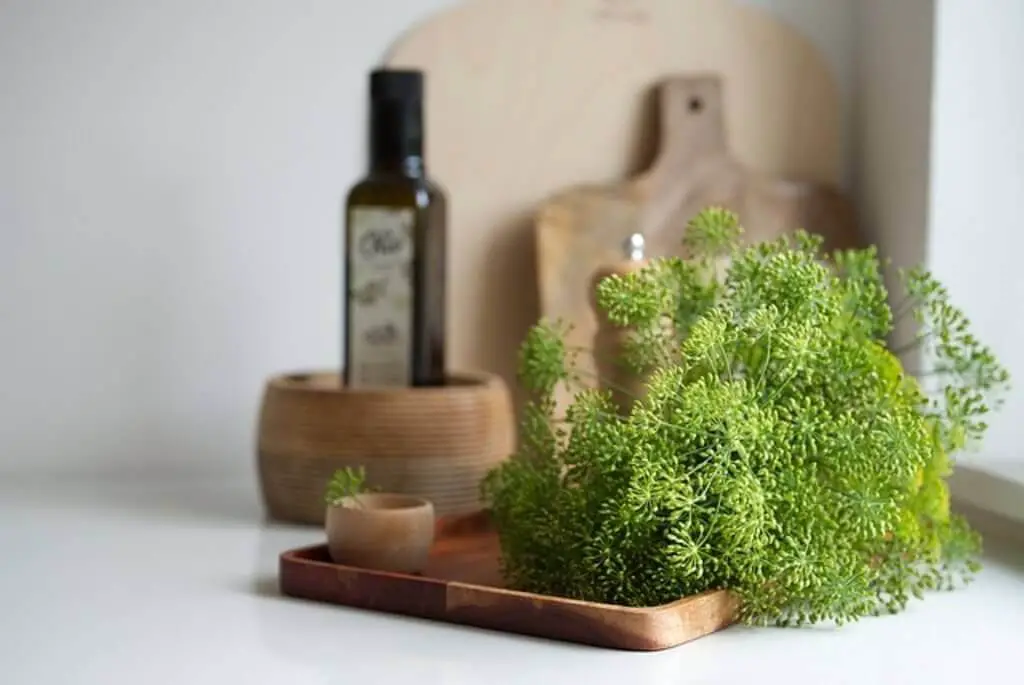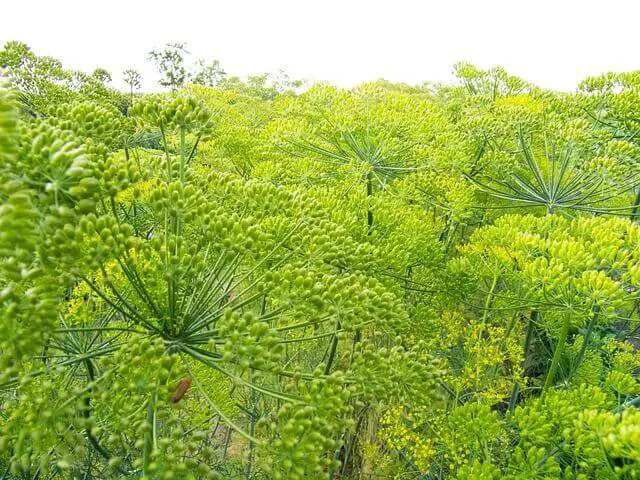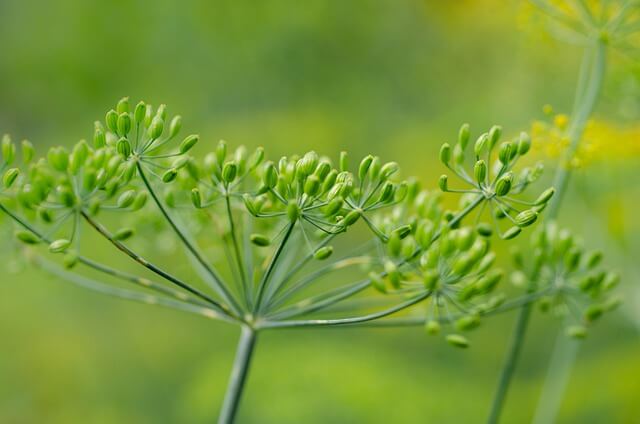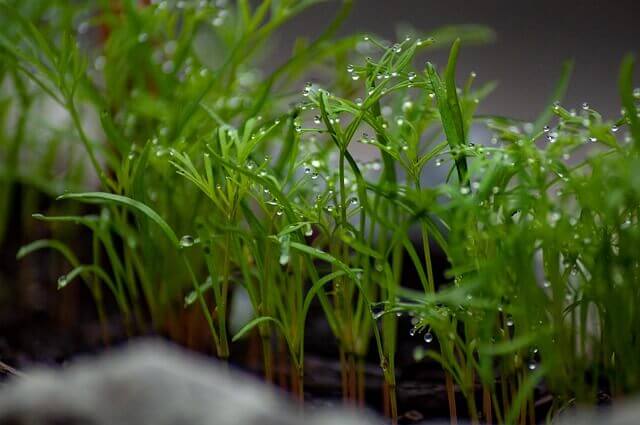61 Fun Facts About Dill (with Photos, ID & Info)
If you’re reading this article, then I’m guessing that you love dill. Dill is a tasty herb that goes well with just about anything! Whether it’s for salads, dips or soups, dill can be used in all of them.
But what other fun facts do we know about the herb? Well let’s find out! Check out these 61 fun facts about dill with photos, ID & with tons of info.
Table of Contents
Overview
- Kingdom: Plantae
- Clade: Tracheophytes
- Clade: Angiosperms
- Clade: Eudicots
- Clade: Asterids
- Order: Apiales
- Family: Apiaceae
- Subfamily: Apioideae
- Tribe: Apieae
- Genus: Anethum
- Species: A. graveolens
- Binomial Name: Anethum graveolens (Carl Linnaeus)
- Scientific Name: Anethum graveolens
- Native Area: Mediterranean countries, southeastern Europe, South to West Asia.
- Plant Type: Annual.
- Flower Type/Color: Yellow.
- Propagation: Seed, cuttings, and division.
- Plant Height: 24-48″ inches (2.0-4.0 feet).
- Plant Spacing: 12-18″ inches. (1.0-1.5 feet).
- Hardiness Zones: 2, 3, 4, 5, 6, 7, 8, 9.
- Bloom Time: Late summer, early fall.
- Harvest Period: est. 90 days or 3 months (after sowing).
- Sun Exposure: 6-8 hours of Full or Partial Sun.
- Soil Type: Use a well-draining sandy or loamy mixture.
- Soil pH: 5.0-7.0 (Slightly Acidic to Neutral)
Plant Description
The dill plant is an annual herbaceous plant with finely divided feathery leaves that resemble parsley but have a delicate aroma from the flowers that grow up to 4 inches long.
This herb can grow to over two feet in height, with the flower heads being about the same size. It has a wiry stem that can be covered with long, thin leaves. The flowers are usually yellow, but they will also be purple or white depending on the variety of dill plant being grown.
Dill is part of the celery family, which also includes fennel. The dill plant can grow up to four feet high and spread out of control once it unfolds its seeds, which are produced at the base of each flower head.
Fun Facts About Dill
- Dill has been used for medicinal purposes for hundreds of years; it has antispasmodic properties that can help people with colic, digestive problems, arthritis and gas pains. It also contains carvacrol which gives it its characteristic flavors and aromas and is believed to activate digestion.
- Dill is a common herb used to flavor foods such as pickles and fish.
- The word dill comes from the Old English dyll or dylle, meaning to soothe or lull.
- The name dill may come from “Jewish holy herb”, as it was sometimes grown near other herbs in Jewish gardens to be easily discernible for religious purposes.
- Dill oil is extracted from dill seeds by crushing them.
- Dill is easy to cultivate and can self-seed to create a powerful “weed” problem.
- There is little difference between dill and cilantro, except for growing conditions. Cilantro is grown in hot tropical climates such as Mexico where dill grows in cooler temperate climates such as Europe, Russia, and North America.
- Dill is harvested before flowering at the end of July or early August for seed heads. Cultivated dill leaves can be harvested throughout the growing season for both culinary and medicinal purposes.
- Dill can be dried or frozen, thereby increasing its flavor potency.
- Dill seed oil is used in the cosmetic industry in the preparation of lotions and creams.
- Dill is considered to have phytoestrogenic properties that are beneficial for women who are entering menopause.
- Dried dill leaves are often used for flavoring in smoking products.
- Dill is used for flavoring in pickles such as kosher dills, and the brine is also used for pickling.
- Dill seed oil can be mixed with lavender and geranium oils to make a homemade insect repellent.
- Dill leaves can reach up to 12 inches high and 1 inch wide, and the seeds grow in clusters of 10-14 at the top of each leaf stalk.
- When the leaves and flowers of dill are added to milk or boil them in milk, they make a good medicinal treatment for sore throat and tonsillitis.
- Dill is an annual herb that grows to a height of about two to four feet.
- Dill plants can grow in almost any soil type, and they don’t need much space to grow and spread.
- Dill leaves look like ferns, and they can be either curly or flat.
- The stems of the dill plant are hollow and smooth, with purple blotches on the outside of them.
- You can harvest dill at anytime, but it is best to do so before the plant blooms because once the plant blooms it will lose its flavor. The seeds should be harvested when they turn brown, but before they burst open, in order to get their maximum flavor potential.
- Dill is a very easy herb to grow, it only takes about two months to reach maturity.
- Dill seeds can be grown indoors by growing them in pots filled with soil.
- Dried dill is not as good as fresh dill because most of the flavor has already been extracted from the plant. To get the full flavor of fresh dill, you need to harvest it before the flower blooms and just after it has turned yellow.
- Dill pairs well with almost any dish because it has an aromatic flavor that works well with meats, fish, cheese and many other foods.
- Dill is the herb of choice to use when making cabbage rolls because it adds a very strong flavor.
- There are many ways to use fresh dill, you can use the leaves to garnish salads, dips or sauces, you can mix it into your mashed potatoes, or you can just eat it plain.
- Dried dill is made by drying the leaves of the plant.
- Fresh Dill makes an excellent garnish for any dish it is used with, but dried will always have an edge over fresh dill in flavor because of the extensive extraction of oils from the plant during drying.
- Dill can be used to make pastes for pickling or preserving foods.
- Dill is also the herb of choice for many Mexican dishes like tacos, enchiladas and chimichangas.
- Fresh dill makes an excellent garnish for hamburgers, hot dogs and other fast food dishes that are eaten on the go.
- The herb can also be used as a garnish over salads or added to soups because it adds an extra flavor to them without being too strong.
- Dill was once called dill-of-cob or dill-of-the-valley because it came from the area where the leaves are abundant in the 5th century BC.
How to Grow Dill from Seed?
How to Germinate Seeds?
I’m going to show you how to grow dill from seed. Before attempting to grow dill, make sure the threat of frost has passed. First, you’ll need a pot of soil and seedling tray. Fill your pot with soil and moisten it (drain off any excess water).
Sprinkle about ten seeds in the middle of your seedling tray, covering them with soil. The soil temperature should be between 60 and 70 degrees (15-21 degrees Celsius). Plant dill seeds in late April through early May. Seedlings should appear in 10 to 14 days.
Sowing Requirements
Sow dill seeds about ¼-inch deep and 18 inches apart.
Soil Requirements
Choose a soil that’s rich in organic matter and is well-draining. The pH of the soil should 5.0-7.0.
Sun Requirements
Plant in an area that will receive full sun with some partial shade. Dill requires at least 6 to 8 hours of sunlight per day, and warm temperatures
Watering Requirements
To water your dill, make sure the soil has dried out completely. Once the soil has dried, water carefully using a sprinkler or hose (again, taking care not to get any of the seeds wet).
In about a week, you should see some tiny shoots start to appear from the soil around your plant. Take care not to over water. Water anytime from mid-morning until mid-afternoon so that the soil is consistently moist all day long.
Related Article: How to Grow Dill at Home? (Growers Guide)










